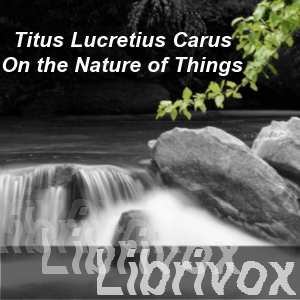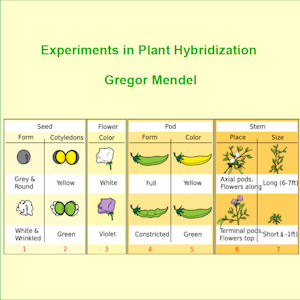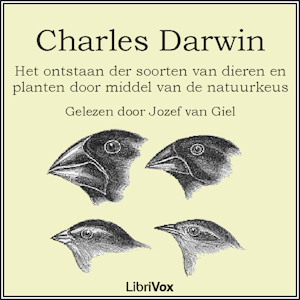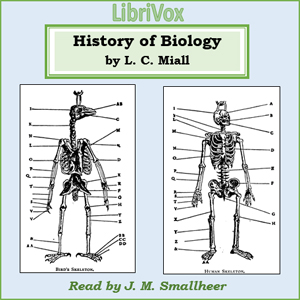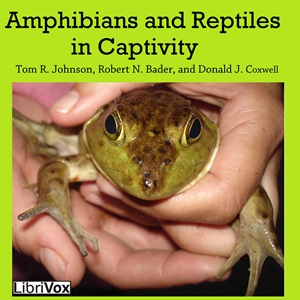Written in the first century b.C., On the Nature of Things (in Latin, De Rerum Natura) is a poem in six books that aims at explaining the Epicurean philosophy to the Roman audience. Among digressions about the importance of philosophy in men's life and praises of Epicurus, Lucretius created a solid treatise on the atomic theory, the falseness of religion and many kinds of natural phenomena. With no harm to his philosophical scope, the author composed a didactic poem of epic flavor, of which the imagery and style are highly praised. (Summary by Leni)
19 episodes
Gregor Mendel was an Augustinian monk in the St. Thomas monastery in Brno. His seminal paper "Experiments in Plant Hybridization" presents his results of studying genetic traits in pea plants. It is the ground breaking work on inheritance, being the first to differentiate between dominant and recessive genetic traits. His work was long ignored and deemed controversial, however, at its rediscovery at the turn to the 20th century, it earned Gregor Mendel the title "father of modern genetics". (Summary by Availle)
11 episodes
Het ontstaan der soorten (Engels: The Origin of Species) is het bekendste boek van de Britse bioloog Charles Darwin. In het boek zet Darwin zijn evolutietheorie uiteen, volgens welke al het leven op aarde een gemeenschappelijke afstamming heeft en natuurlijke selectie het belangrijkste mechanisme voor het ontstaan van soorten en de aanpassing van soorten aan hun milieu is. (Introductie door Jozef Van Giel)
In sectie 20 wordt in de audio verwezen naar een figuur, met een link die niet meer werkt. Deze figuur is wel te vinden onder deze link.
86 episodes

“Society lies under the spell of ancient terrorism and coagulated errors. Science is either wilfully hypocritical or radically misinformed.”
John Addington Symonds struck many an heroic note in this courageous (albeit anonymously circulated) essay. He is a worthy Virgil guiding the reader through the Inferno of suffering which emerging medico-legal definitions of the sexually deviant were prepared to inflict on his century and on the one which followed. Symonds pleads for sane human values in a world of Urnings, Dionings, Urano-Dionings and Uraniasters - in short, the whole paraphernalia of Victorian taxonomies and undigested Darwinism which, superimposed on the “terrorism” of religion, labelled and to some extent created the specimen “homosexual.”
A discussion of the “manly love” poems of Walt Whitman leads the author to speculate on a better future for the criminalised mutual passions of men; yet he is obliged to defer the dream, for “the world cannot be invited to entertain it.” (Introduction by Martin Geeson)
22 episodes
The author explores the effects of condensation and evaporation as they relate to the success of a beehive. The results of various experiments and the author's thoughts are given. (Summary by SoMDbeekeeper)
5 episodes
This is more than a book about bees and their lives; the author talks about his cats, red ants, and insect psychology in general. Jean Henri Fabre also made waves in his native 19th Century France by insisting that girls be included in his science classes, so I dedicate this recording to certain young women who risk their lives or even the less important attentions of boys simply to learn. - Summary by BellonaTimes
12 episodes
A history of biology from ancient times to Darwin and Pasteur by Louis Compton Miall, Professor of Biology, Fellow of the Royal Society, Fullerian Professor of Physiology and Comparative Anatomy at the University of Leeds. This book covers all the major advances in botany and zoology through the mid-1800's and concludes with the impact that Darwin's "Origin of Species" and Pasteur's research into microorganisms will have on future generations of biologists. (Summary by J. M. Smallheer)
“Science knows no country, because knowledge belongs to humanity, and is the torch which illuminates the world.” – Louis Pasteur
13 episodes
Multi-volume work on science edited by Francis Rolt-Wheeler. The fifth volume is on Biology written by Caroline E. Stackpole. It discusses biology being the science of life and life’s nature and origins. It furthers explains functions and processes necessary for this life. It also covers evolution and factors that affect evolution. - Summary by Sienna
27 episodes
Creative Evolution (French: L'Évolution créatrice) is a 1907 book by French philosopher Henri Bergson. Its English translation appeared in 1911. The book provides an alternate explanation for Darwin's mechanism of evolution, suggesting that evolution is motivated by an élan vital, a "vital impetus" that can also be understood as humanity's natural creative impulse. The book was very popular in the early decades of the twentieth century, before the Neodarwinian synthesis was developed.The book also develops concepts of time (offered in Bergson's earlier work) which significantly influenced modernist writers and thinkers such as Marcel Proust. For example, Bergson's term "duration" refers to a more individual, subjective experience of time, as opposed to mathematical, objectively measurable "clock time." In Creative Evolution, Bergson suggests that the experience of time as "duration" can best be understood through creative intuition, not through intellect. - Summary by Wikipedia
22 episodes
This book is devoted to the study of invertebrate animals. While most people associate the word "animal" with fish, amphibians, reptiles, birds, and mammals, 90% of the animal species on earth are invertebrates, i.e., they have no backbone. Protozoans and invertebrate animals are found world-wide, from the bottom of the oceans to the the rain forests, ice caves, and our own back yards. Many invertebrates still reside in the oceans, while others dwell in our houses, back yards and gardens, in ponds and streams, and on the menus in seafood restaurants. Holders's book represents a traversal of several dozen familiar and not-so-familiar animals without backbones whose ancestors date back to the Cambrian period 500 million years ago. (Summary by Jefferey Smith)
30 episodes
The Elements of Anatomy and Physiology is one in a Series of First Books of Natural History Prepared for the Use of Schools and Colleges. This succinct little textbook from 1852 presents an introduction to the workings of the human body. The information, albeit not current, is still interesting and of use as a general overview of the subject as well as interesting look into the period. Please note that some of the information may have changed considerably since this time. The author was a surgeon in the U.S. Navy and president of the Academy of Natural Sciences. - Summary by A. Gramour
14 episodes

The book is intended to ground beginners in Structural Botany and the principles of vegetable life, mainly as concerns Flowering or Phanerogamous plants, with which botanical instruction should always begin; also to be a companion and interpreter to the Manuals and Floras by which the student threads his flowery way to a clear knowledge of the surrounding vegetable creation. Such a book, like a grammar, must needs abound in technical words, which thus arrayed may seem formidable; nevertheless, if rightly apprehended, this treatise should teach that the study of botany is not the learning of names and terms, but the acquisition of knowledge and ideas. No effort should be made to commit technical terms to memory. Any term used in describing a plant or explaining its structure can be looked up when it is wanted, and that should suffice. On the other hand, plans of structure, types, adaptations, and modifications, once understood, are not readily forgotten; and they give meaning and interest to the technical terms used in explaining them. - Summary by Asa Gray
22 episodes
Published in 1665, this is the first publication of the Royal Society and considered to be the first scientific best-seller. As opposed to the Latin of other publications of the time like Newton's 'Principia Mathematica', it was written in English to make it accessible to all. Robert Hooke uses the then fairly new microscope to cover many different subjects including insects, plants, organic material, and even the stars and moon, all fully illustrated by Hooke in detailed hand-drawn diagrams.
The many illustrations which are frequently referenced can be found here (Summary by Jordan)
66 episodes
Radioisotopes in Medicine is an educational booklet published in 1966 as part of the Understanding the Atom series by the United States Atomic Energy Commission. Written in clear language for the general public, the booklet covers the diagnostic and therapeutic uses of radioactive isotopes like technetium 99m and iodine 131. (Summary by Laurie Anne Walden)
5 episodes
Translated from Italian, it delves into the physiology of love from a scientific standpoint, in beautiful writing.
37 episodes
Asa Gray was a highly-regarded botanist at Harvard University and a friend and collaborator of Charles Darwin. As a Christian, Gray was concerned with the disconnect developing through the nineteenth century between the growing understanding of the natural world and the traditional worldview assumed by orthodox Christianity. This book presents two lectures he gave to theology students at Yale College in which he argues that a disconnect is not inevitable, but that a Christian perspective can and should incorporate current understanding of the world provided by natural science. - Summary by BarryGanong
4 episodes

Botanical Piracy! A French botanist plots to steal red dye cochineal insects from Spanish Mexico and transplant them and their cacti hosts to the French Caribbean. The year is 1776. Nicolas-Joseph Thiéry de Menonville is a fast talker and a quick thinker. Botanist and physician by training, he insinuates his way from Port-au-Prince, first to Havana and then to the Mexican mainland on the ruse that he is searching for a botanical cure for gout. In Vera Cruz, however, his passport is confiscated, and the Viceroy orders him to leave Mexico on the first available ship. There are three weeks to wait before the ship sails. Thiéry de Menonville concocts a daring plan. Circulating the story that he is spending the interval before his departure at the country estate of an alluring widow, he instead climbs over the city wall of Vera Cruz in the dead of night and sets out on foot for Oaxaca and its cochineal plantations, no matter that he is ignorant of the exact route to take. Not daunted, he stops at a monastery and tells the monks he has made a vow to walk on foot to Nuestra Señora de la Soledad in Oaxaca, and the monks point him on the right road. How Thiéry de Menonville succeeds in bringing living cactus and cochineal insects to the French colony of Saint-Domingue is a non-stop adventure tale. - Summary by Sue Anderson
22 episodes
On the Parts of Animals (Greek: ΠΕΡΙ ΖΩΩΝ ΜΟΡΙΩΝ; Latin: De Partibus Animalium) by Aristotle (ΑΡΙΣΤΟΤΕΛΗΣ). The first book asks whether animals were designed or came into existence by chance. The remaining three books focus on particular examples of various animals and the functions of their organs. The translator William Ogle, who was both a medical doctor and classicist, presented Charles Darwin with a copy of this translation. (Adapted from Wikipedia by Geoffrey Edwards)
10 episodes
Prior to the emergence of paleontology and comparative anatomy as scientific disciplines at the end of the 18th century, it was generally known that there were species of animals that had disappeared completely. The term "extinction" originally applied to the extinguishing of fires or erasing of one's debt. It was not until 1784 that the term extinction was used to denote the complete eradication of a species of living being. In 1901, Frederic A. Lucas penned an overview of vertebrate animals whose only evidence of being remained in fossil records. The book focuses primarily on vertebrate animals, from fish to mammals. - Summary by Jeffery Smith
13 episodes
An examination of Charles Darwin's theory of evolution and subsequent texts, written for the general public at the turn of the twentieth century, "[...] to dwell on the various significant facts that have been discovered since Darwin's time, and to offer certain lines of evidence never before presented in this connection and which seem to add much strength to the general argument.[...]" (Preface) - Summary by Kathleen Nelson
14 episodes
In recent years the number of people interested in keeping amphibians and reptiles in captivity has grown rapidly. All too often, these same people have little knowledge of the proper care needed for their captives, nor do they know where to turn in order to learn the needs of their animals.
It is the intent of the authors of this special issue to offer the proper information needed to successfully keep amphibians and reptiles in captivity. We are by no means THE experts on the subject, nor do we claim to cover all the facts. However, we do hope that enough information is furnished to answer most of the common questions asked by people.
- Summary by Tom R. Johnson
6 episodes

John Woodhouse Audubon (1812-1862), son of the famous painter John James Audubon and an artist in his own right, joined Col. Henry Webb's California Company expedition in 1849. From New Orleans the expedition sailed to the Rio Grande; it headed west overland through northern Mexico and through Arizona to San Diego, California. Cholera and outlaws decimated the group. Many of them turned back, including the leader. Audubon assumed command of those remaining and they pushed on to California, although he was forced to abandon his paints and canvases in the desert…. Throughout the whole of this long journey Mr. Audubon took notes of scenes and occurrences by the way. In his descriptions he exhibits the keen observation of the naturalist and the trained eye of the artist. The result is a remarkable picture of social conditions in Mexico, of birds and trees, of sky and mountains and the changing face of nature, of the barrenness of the desert and the difficulties of the journey, of the ruined missions of California, of methods of mining, and of the chaos of races and babel of tongues in the gold fields. It was manifestly impossible to keep a daily journal, and the entries were made from time to time as opportunity occurred. Considering the circumstances under which they were taken, the notes are remarkable for their accuracy. Because it was not edited by Audubon, the text (and this recording) ends abruptly. - Summary by Book Introduction and David Wales
11 episodes
Sir Richard Owen coined the term "dinosaur" ("Terrible Reptile" or "Fearfully Great Reptile") in the 19th century. When Harry G. Seeley, a student of law at that time, attended a lecture on flying reptiles, his interest in paleontology was piqued, and he pursued paleontology for the remainder of his life. He determined that dinosaurs could be divided into two groups, the lizard-hipped dinosaurs and the bird-hipped dinosaurs. He is also credited with characterizing flying dinosaurs as warm-blooded active flyers rather than cold-blooded passive gliders. His popular book on the flying dinosaurs, Dragons of the Air, is a comprehensive treatise on the structure, classification, and possible evolutionary origins of the Pterosaurs as well as their relationship to birds. - Summary by Jeffery Smith
19 episodes
In this early nineteenth-century classic, William Paley assesses how our understanding of nature reflects characteristics of its creator. First published in 1802, the book went through more than twenty editions, remains in print, and is still a reference point in the ongoing conversation about evolution or creation as the better explanation for the appearance of order and design in our universe. - Summary by Barry Ganong
32 episodes
Although published to promote the business of walnut production, this short volume describes the current science and practice of growing walnuts in the early twentieth century with particular reference to the state of Oregon. - Summary by Larry Wilson
13 episodes
